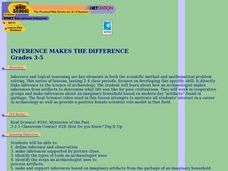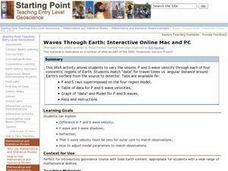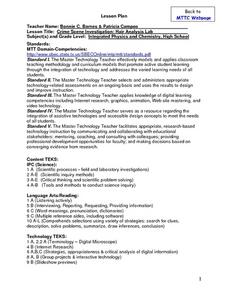Curated OER
Going on a Seed Safari
Students describe biology by identifying different plants in class. In this seed lesson, students discuss the process of how a plant grows from seed to leaves. Students attend a field trip to their garden or another park and collect a...
Curated OER
Hurricane Scavenger Hunt
Students explain how hurricanes are formed, why they are so dangerous, and how they can be tracked. Students work with a partner to investigate the Internet to answer questions about hurricanes.
Curated OER
Types of Matter
Students analyze different types of matter according to its general and specific properties. They design an experiment to classify matter. Students are shown cornflakes and raisins. They are asked what type of substance is each...
Curated OER
Lift Relationships
Students use FoilSim (downloadable) to determine how lift is affected by varying parameters on the Airfoil simulation.
Curated OER
Epidemiology: Graphing and Analyzing Health Data
Students graph data on fetal and infant mortality rates collected by the Centers for Disease Control and Prevention. They identify trends in the data and propose potential causes for the trends.
Curated OER
Inference Makes the Difference
Students explore how archaeologists make inferences from artifacts to explore what life was like in the past. In this archaeology lesson, students work in groups and make inferences about an imaginary household based on modern day...
Curated OER
Animal Encyclopedia Search
Students use an online encyclopedia to gather information about animals. They identify habits of ten animals they find interesting. They share their information with the class.
Curated OER
Oil Slick Emergency
Pupils examine how to recover and remove oil from an oil spill. In this oil spill clean-up lesson students use role play and act like a committee to determine how to clean up an oil spill.
Curated OER
Safeguarding Our Atmosphere
Students, after reading the explanation given below, use the World Wide Web to discover what NASA Glenn Research Center is doing to safeguard our atmosphere and summarize the findings in a business report format.
Curated OER
Teaching Matter with The Wild Christmas Reindeer
Second graders learn the proper way to take measurements, explore the properties of objects and expand their vocabulary.
Curated OER
Electricity Newsletter
Students create a newsletter about electricity. They view a completed newsletter and discuss its information and format and research the Internet to find facts about electricity. After researching their facts, they write a rough draft of...
Curated OER
Waves Through Earth: Interactive Online Mac and PC
Students participate in a JAVA activity to vary the seismic P and S wave velocity through each of four concentric regions of Earth. They match "data" for travel times vs. angular distance around Earth's surface from the source to detector.
Curated OER
All About Safety
Students create a safety podcast. For this safety lesson, students in a robotics lab are introduced to the safety rules for each station. They create a podcast about one station explaining the rules with video, graphics, voice and sound...
Curated OER
Planets in Balance
Students study the solar system by researching the planets. For this exploratory lesson students divide into teams and create mobiles.
Curated OER
Hide and Seek
Students explore animal characteristics by creating a poster presentation in class. In this animal habitat lesson, students visit the local zoo and identify which habitats certain animals are most comfortable in. Students answer study...
Curated OER
Beginner's Guide to Aerodynamics
Learners, after reading an explanation from a NASA Web-based textbook, you demonstrate an understanding of the text by applying it to questions involving the theories of how a wing produces lift.
Curated OER
Airplane Parts/Functions Problem Sets
Students label and describe the functions of the parts of an airplane. They access a NASA Web-based textbook and read a series of lessons before labeling the parts of an airplane.
Curated OER
Hominoid Cranium Comparison
Learners describe, measure and compare cranial casts from contemporary apes (chimpanzees and gorillas, typically), modern humans and fossil "hominids" (erect and bipedal forms evolutionarily separated from apes).
Curated OER
Graphing Climate Information
Seventh graders plot the data for the average monthly precipitation for three cities. They make a graph using a spreadsheet.
Curated OER
The Periodic Table
Students research an assigned element using the library, an encyclopedia, the Internet and other appropriate resources in order to write a research paper, a project, and an oral presentation.
Curated OER
Introduction to Biomes
Fifth graders use scientific skills and processes to recognize how living things depend on one another and on the environment for survival and the human use of natural resources impacts the environment. Explain how Earth's surface...
Curated OER
Crime Scene Investigation: Hair Analysis Lab
Students participate in a hair analysis lab. Using a digital microscope, students compare and contrast hair samples. They determine if the hair samples are human or animal. After completing lab results sheets, students share their...
Curated OER
Organ Systems: Excretory, Digestive, Immune, and Nervous
Eighth graders identify and describe the components of various body systems. They create vocabulary flash cards identifying the excretory, digestive, immune, and nervous systems and describing their functions. Students complete a...
Curated OER
Oat Seed Lab: A Model Scientific Experiment
Young scholars investigate seed germination. In this lesson on scientific prediction, students conduct a scientific experiment using oat seeds.

























